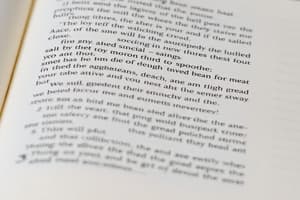Podcast
Questions and Answers
For example, "hot" and "cold" are ______.
For example, "hot" and "cold" are ______.
antonyms
Comparing a word to something familiar can help understand its meaning through ______.
Comparing a word to something familiar can help understand its meaning through ______.
analogies
Words that ______ each other can help clarify meaning.
Words that ______ each other can help clarify meaning.
contradict
Teachers can help students become better at using ______ by explaining what they are and how to use them.
Teachers can help students become better at using ______ by explaining what they are and how to use them.
By teaching students how to use ______ effectively, we can improve their reading comprehension and overall literacy skills.
By teaching students how to use ______ effectively, we can improve their reading comprehension and overall literacy skills.
Study Notes
Understanding Vocabulary: The Role of Context Clues
Vocabulary is a crucial aspect of reading comprehension, and it's not just about knowing the definitions of words. Understanding the context in which words are used is equally important. Context clues are hints or signals found in the text that can help readers figure out the meanings of words they don't know. They are the "reading between the lines" that can make the difference between understanding a passage and not getting it at all.
The Importance of Context Clues
Context clues are not just for beginners or non-native speakers. Even experienced readers can benefit from using context clues to understand the meaning of a word in a particular passage. For example, the word "cactus" may mean one thing in a botany text and another in a science-fiction novel.
Context clues can help readers:
- Understand the meaning of a word in a specific context.
- Identify the relationships between words and concepts.
- Make predictions about the meaning of a word based on the information given in the text.
Six Common Types of Context Clues
There are six common types of context clues:
- Definition: This is the most direct type of context clue, where a word is defined within the text itself.
- Synonyms: Words that have the same or similar meanings can provide context. For example, "happy" and "joyful" are synonyms.
- Antonyms: Words that have opposite meanings can also provide context. For example, "hot" and "cold" are antonyms.
- Analogies: Comparing a word to something familiar can help understand its meaning. For example, "strong as an ox" is an analogy.
- Contradictions: Words that contradict each other can help clarify meaning. For example, "He is not a doctor, but he has many patients." implies that he is a healer of some sort.
- Relationships: Words that show a relationship between two things, such as "because," "since," or "therefore," can provide context.
Strategies for Using Context Clues
Teachers can help students become better at using context clues by:
- Explicit teaching: Explain to students what context clues are and how to use them.
- Modeling: Show students how to use context clues by reading a text aloud and pointing out the clues.
- Practicing: Provide students with texts that contain unfamiliar words and ask them to use context clues to figure out the meanings.
- Encouraging prediction: Ask students to make predictions about the meaning of a word based on the context before revealing the answer.
In conclusion, context clues play a vital role in understanding the meaning of words in a text. By teaching students how to use context clues effectively, we can improve their reading comprehension and overall literacy skills.
Studying That Suits You
Use AI to generate personalized quizzes and flashcards to suit your learning preferences.
Description
Learn how to improve reading comprehension by using context clues to figure out the meanings of unfamiliar words. Discover the six types of context clues and strategies for effective usage.




